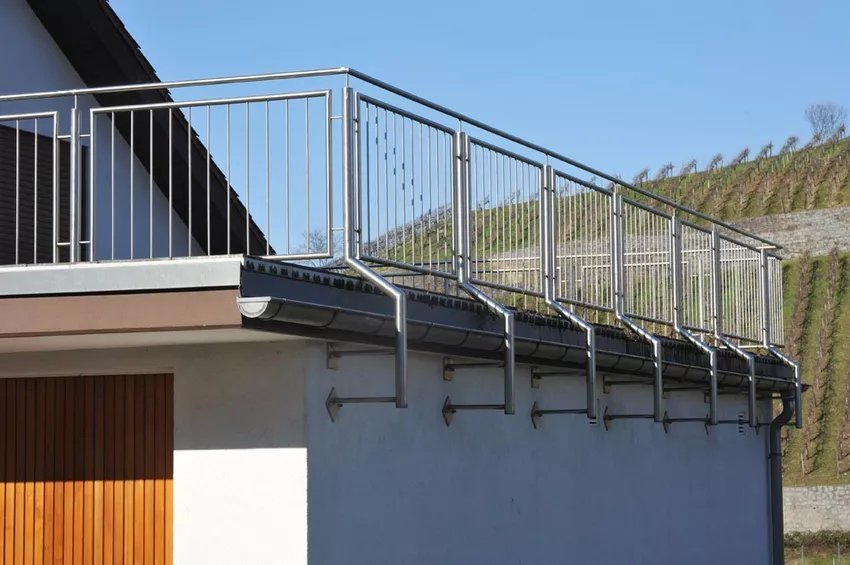It's bearable on a roof terrace. Only when the sun is particularly kind could it become dangerous without suitable protection. You can find out here which types of sun protection are possible for roof terraces.

Roof terraces have their very own charm. You sit high above the rooftops and look out over the city that surrounds you. Especially in summer, a roof terrace invites you to relax and linger. Here you can spend many cozy hours with family, friends and acquaintances. But no matter how beautiful a roof terrace is, in midsummer temperatures often make it almost impossible to use it.
In order to be able to enjoy the roof terrace even in midsummer, it is essential to install suitable sun protection. So nothing stands in the way of a comfortable stay on the terrace, even in tropical temperatures.
I would like to explain to you exactly what options there are for roof terraces.
4 sun protection options for roof terraces
❖ Awnings as sun protection

The easiest way to protect yourself from the sun's UV rays is with an awning. These are not only relatively simple in construction, but can also be quickly retracted and extended. In addition to protection from the sun, they also offer protection from light rain. When it is windy, however, awnings should always be retracted.
» Important: If you live in a rented apartment, you must ask the landlord in advance whether the installation of an awning is permitted.
The cost of an awning varies greatly. On the one hand, it depends on whether you decide on an awning with a hand crank or whether you want it to be extended and retracted electrically. The second variant costs significantly more, of course, but is significantly lighter in terms of functionality. On the other hand, it also depends on the size of the area to be shaded. The larger the model, the more expensive it is. But be careful - the larger the awning, the larger the surface area for the wind to attack. You should therefore prefer to use a cassette awning for large areas to be shaded. This has two armsand is therefore a lot more stable than conventional awnings and also more resistant to wind.
» My tip: Especially with roof terraces, it is often the case that the standard dimensions do not fit. If you need something a little more individual, you can have a sun protection made to measure, e.g. at markise24.de.
❖ Awning as sun protection

As a second variant, I would like to introduce sun sails to you. You can also easily use these as sun protection for roof terraces. They are available in different designs and colors, so everyone should be able to find something for their taste. In my opinion, they are visually a nicer alternative to the awnings, but everyone decides that for themselves. The only disadvantage compared to awnings, however, is that sun sails cannot be retracted and extended electrically.
You need additional stable attachment points to attach sun sails. For roof terraces, it is advisable to set up a stable mast on which the corresponding sail can be hung.
» Important: Make sure you have adequate UV protection when you buy it. Corresponding models are marked with the note "UV Standard 801". You can read about the criteria according to which textiles receive this “badge” in the Hohenstein.de guide.
❖ Parasols for sun protection

Not to be forgotten is the classic parasol. It can also provide sufficient sun protection on a roof terrace. But you should be careful here, because not all parasols are suitable for this. The normal parasols are often too small, which is why people like to use cantilever parasols, as they are easily available in much larger sizes. Due to the free arm, these parasols offer significantly more space underneath than the parasols with a central pole, but they also have a decisive disadvantage for roof terraces. They offer a large surface area for wind, which is not well distributed by the side arm. This means that the umbrella could fly over the terrace even at low wind speeds.
So parasols with a central mast, which are not affected by strong winds, are much better. The all-weather umbrellas from sunliner.de, for example, can be set up in wind speeds of up to 84 km/h. They are also completely waterproof.
In order to avoid greater damage, it is better to close the umbrella when you are away and in a strong storm.
❖ Fixed roof construction

After the options mentioned above, which can be dismantled and put away at any time, I would now like to suggest a fixed roof construction. Here you have a bit more work to build them, but then you can rest.
However, such a solid construction is only possible for private property and then only if it has been approved under building law. You can find out from the competent authority in your place of residence whether a permit is required and if so, to what extent. Unfortunately, I can't make a specific statement on this, since the regulations differ depending on the federal state.
If you want to choose a fixed canopy for sun protection, you can choose between the materials wood and aluminum for the frame. Aluminum is much more weather-resistant, but wood exudes a little more coziness. The downside to aluminum is that wood needs regular painting. Polycarbon sheets are often used as a roof.
Which variant you finally decide on also depends on the local conditions. With the right sun protection, nothing should stand in the way of cozy and sheltered hours on the roof terrace, despite the intense heat.